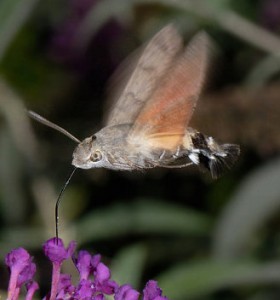 When you think of the word hovering, most people think of a hummingbird because of its flight traits. The hummingbird hawk moth, also known as the Macroglossum Stellatarum has a flight pattern very similar to the hummingbird, which is an excellent hovering animal.
When you think of the word hovering, most people think of a hummingbird because of its flight traits. The hummingbird hawk moth, also known as the Macroglossum Stellatarum has a flight pattern very similar to the hummingbird, which is an excellent hovering animal.
These sphingid moths are found in Europe, North Africa, and Asia, for their warmer climates, but do not last long during the winter. Along with the hovering wing aspect of the moth, the Macroglossum Stellatarum also has a long, straw-like mouth, similar to the hummingbird’s long beak, which is used to suck nectar from flowers. This straw-like mouth is called a proboscis.
Some features that allow this moth to fly effectively are its narrow wings and aerodynamic body. The moth’s narrow wings are able to flap rapidly, sustaining a steady, leveled flight, or hover as it retrieves nectar from flowers. Size of the wingspan can vary from a small 40mm to a larger 10 cm. The hawk moth’s aerodynamic body allows for fast cutting motions used to circle around a patch of flowers when collecting nectar. This phenomenal flyer is able to reach speeds of 12 mph when flying instead of hover.
The video above shows the moth’s amazing stability when it hovers around flowers.
Sources
1) Scoble, Malcolm J. (1995): The Lepidoptera: Form, Function and Diversity (2nd edition). Oxford University Press & Natural History Museum London. ISBN 0-19-854952-0
2)Kitching, Ian J. (2002): The phylogenetic relationships of Morgan’s Sphinx, Xanthopan morganii (Walker), the tribe Acherontiini, and allied long-tongued hawkmoths (Lepidoptera: Sphingidae, Sphinginae). Zool. J. Linn. Soc. 135(4): 471-527. doi:10.1046/j.1096-3642.2002.00021.x (HTML abstract)
3)Kelber, Almut (1996). “Colour learning in the hawkmoth Macroglossum stellatarum” (PDF). Journal of Experimental Biology 1119 (5): 1127–1131. PMID 9318956
4)BBC 2011. “Daytime moth”. From Life in the Undergrowth: Hummingbird hawk moths seek out nectar by day. Nature wildlife. Retrieved September 28, 2011 fromhttp://www.bbc.co.uk/nature/life/Macroglossum_stellatarum#p003kmgn
2 Comments
Galen Perry posted on December 5, 2012 at 6:12 pm
Awesome video. Any clue why it’s called a hawk moth? I can’t believe how similarly it looks and behaves to hummingbirds, though!
Lorena Barba posted on December 23, 2012 at 6:57 pm
I dare say, you did not really find any facts for this piece in Kelber’s 1996 article which is about how these insects learn colors! Why list it among your sources?